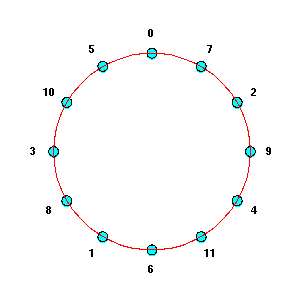piano3The mathematics of piano tuning
3. The equal-tempered keyboard
The interval from a note to the note of twice the frequency is called an octave, while the interval to the note of 3/2 the frequency is called a perfect fifth. These are the most natural intervals in music. But for a piano to be able to play down an octave and up perfect fifth for each of its notes would require an infinite number of keys. The compromise solution in common use since the middle of the nineteenth century is equal temperament. It is based on a rational approximation to log23. The continued fraction approximation of frac(log23) yields 1/2, 3/5, 7/12, 24/41, ... as best rational approximations. The one to take is 7/12.
 | With 7/12 as approximation to frac(log23), iterating the "third harmonic" construction yields exactly twelve pitch classes. If "0" corresponded to C on a piano, then the pitch classes would runas follows: | 0 | 1 | 2 | 3 | 4 | 5 | 6 | 7 | 8 | 9 | 10 | 11 | | C | G | D | A | E | B | F# | C# | G# | D# | A# | F |
Since the interval from each note to the next is a (not quite perfect) fifth,this sequence ofpitch classes is referred to as "the circle of fifths." |
The beauty ofequal tempering is that the whole arrangement has a rotational symmetryof order 12. A piano piece written with starting pitch C can be "transposed" upso as to start with F by shifting each note five steps clockwise. No newnotes are required. All therelationships between the notes of the piece will be the same: it willbe the same piece of music, just set higher.
The price paid for this convenience is that none of the intervals,except the octaves, sound quite right. In the NewGrove Dictionary of Music and Musicians there is a 14-page entry for "Temperament" which explains the history of the problem and thepros and cons of the various solutions. In particular it is stillnot known for sure whether the "well-tempering" consecrated by Bach was equaltempering or not. See also the Grove entry for "Well-tempered clavier."Jim Loy's web-page The Well-Tempered Scale comes down squarely on the "or not" side.
Welcome to the
Feature Column!
These web essays are designed for those who have already discovered the joys of mathematics as well as for those who may be uncomfortable with mathematics.
Read more . . .
Feature Column at a glance



